The Tiger’s Nest Monastery hike is one of the best things to do in Bhutan, and probably one of the most amazing day hikes anywhere in the world.
This photogenic Buddhist monastery, also known as Paro Taktsang, clings to the side of a steep cliff that’s 900 meters tall (3,000 feet)! It hardly looks real.
The Tiger’s Nest hike is not too difficult for most people of average fitness, and it’s located fairly close to the main airport in Bhutan. However, because of Bhutan’s unusual tourist tax, this awesome little country is still off the radar for most international tourists.
This travel guide will explain how to do the Tiger’s Nest Bhutan hike, how to get there, what to expect in terms of difficulty, and everything else you need to know before you go!
Tiger’s Nest: Quick Facts
- Distance: 6 kilometers (3.7 mi) round trip
- Elevation Gain: 600 meters (1,970 ft)
- Top Elevation: 3,100 meters (10,170 ft)
- Duration: 4 – 8 hours round trip
- Difficulty: Moderate

Taking a picture at the Tiger’s Nest viewpoint
How To Get To The Tiger’s Nest Monastery In Bhutan
The Tiger’s Nest Monastery is located about 15 kilometers from Paro town and the Paro International Airport in western Bhutan, so it’s relatively accessible.
The paved parking lot is only a 30 minute drive from Paro. The road to the trailhead can be a bit narrow and winding at times, but it’s not a steep or dangerous drive at all. Your tour guide in Bhutan can arrange transportation for you to the start of the trail.
The monastery itself is located on a steep cliff above the Paro valley, so the only way to get there is by hiking. There’s no cable car, and you can’t drive to the top either. No matter who you are, a hike is required!

The Tiger’s Nest Monastery
Tiger’s Nest Monastery Hike: What To Expect
• Starting The Hike
The hike to the Tiger’s Nest Monastery starts out in a dense forest of pine trees. You get your first view of the monastery almost right away, although it’s distant and it looks very small at the top of the mountain.
Early on, you’ll pass some little Bhutanese stupas with prayer wheels inside, and a small stream and waterfall. The hiking path can be a bit rocky and muddy in places, and there are occasionally tree roots to step over. Even though the trail starts in the shade, much of it later on will be in the sun.
This is a very famous hike, so the main trail can be busy with people and also horses, which hikers may rent to help carry them partway up the mountain. This means you have to dodge horse poo along the trail.
You should give the horses plenty of space when they pass, because you don’t want to be kicked. Thankfully, the horses have bells, so you can always hear them coming.
A good local tour guide can also show you side routes with more shade and less people. There are lots of lesser used side trails on this hike because of the monastery’s long history as a Buddhist meditation site.

Start of the hike. You can see the monastery barely visible at the top of the mountain!
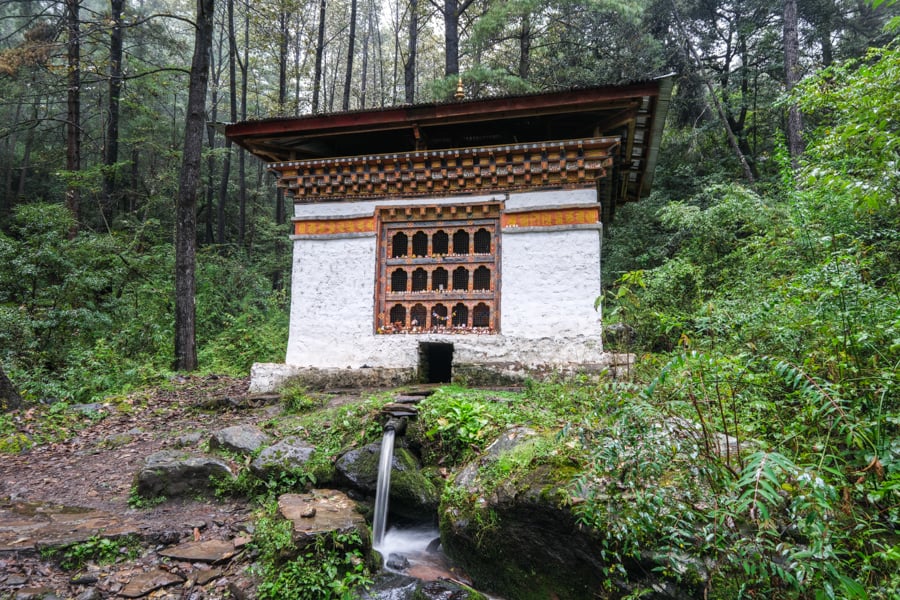
A small stupa by a stream
• Taktsang Cafeteria Views
After you’ve hiked approximately halfway to the Tiger’s Nest Monastery, you’ll reach a nice little mountain cafe called the Taktsang Cafeteria.
This is a great place to stop and rest, and the cafe has good views of the monastery from below. The monastery still looks far away at this point, and there’s plenty of climbing left to do, but your destination is getting noticeably closer.
The monastery is already in range for some good photos if you have a phone or camera lens with a bit of zoom. Meanwhile, you can buy food, drinks, or souvenirs at the cafe, and there are free bathrooms as well.
After leaving the cafe, there are several more nice views of the monastery as you keep climbing the trail. Along the way, we saw magpie birds and grey langur monkeys (including babies)!
The path gradually becomes a bit less steep as you go, until it finally flattens out when you’re getting close to the monastery.

Another glimpse of the Tiger’s Nest — looking through the prayer flags
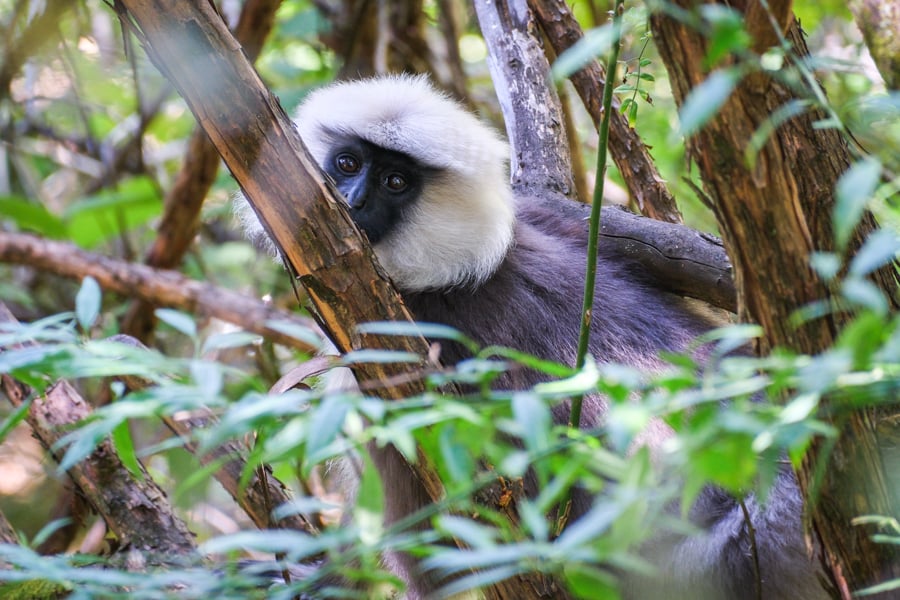
Grey Langur monkey in the forest
• Tiger’s Nest Monastery Viewpoint
After about 2 hours of hiking (or more), you’ll finally reach the famous viewpoint of the Tiger’s Nest Monastery! This is the spot where all the great pictures are taken, showing the building perched on the edge of the giant cliff.
The monastery is extremely photogenic, and any phone or camera will take great pictures of it. You don’t need a special zoom lens or anything like that to get nice photos.
It’s a stunning sight to behold, and I felt like I could’ve stayed there for hours admiring the view. The cliff is massive and it has a sheer drop of more than 900 meters (3,000 feet)!
It’s hard to believe anyone could build something so fantastic on this cliff, especially in 1692 when the monastery was first established. I really think it’s one of my favorite things I’ve seen anywhere in the world.
The viewpoint has several tiers, so there’s lots of room to spread out and take photos. Crowds usually form at the first viewpoint, but you can take even better photos if you keep going lower and closer to the monastery.
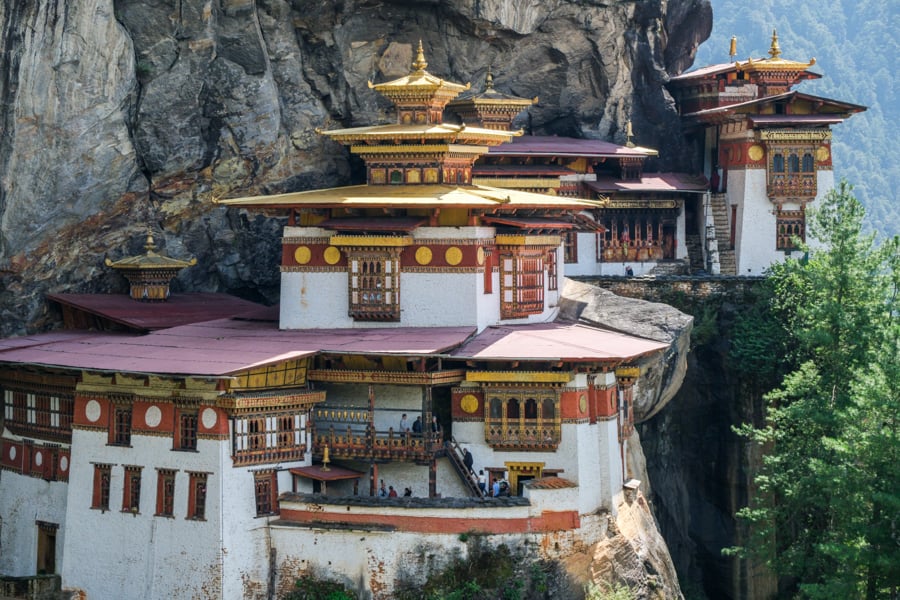
Up close view of Paro Taktsang — the Tiger’s Nest Monastery!
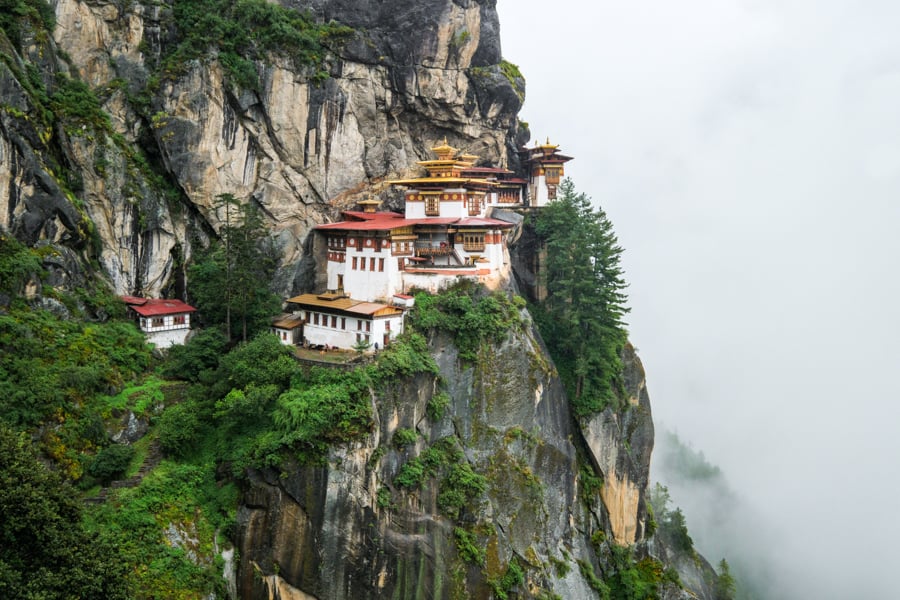
Even a cloudy day can be good for photos at the Tiger’s Nest Monastery
• Taktsang Waterfall & Bridge
From the main viewpoint, in order to reach the Tiger’s Nest Monastery and go inside, you will have to hike down a series of concrete steps and then go up even more steps, but there’s a metal railing you can hold at all times.
At the bottom, you’ll cross a foot bridge over a stream, and pass a tall waterfall with several drops. It’s an impressive waterfall that’s apparently hundreds of meters tall if you measure it from the base of the mountain!
I never knew there was a waterfall at Taktsang Monastery, so this was a fun surprise to see.
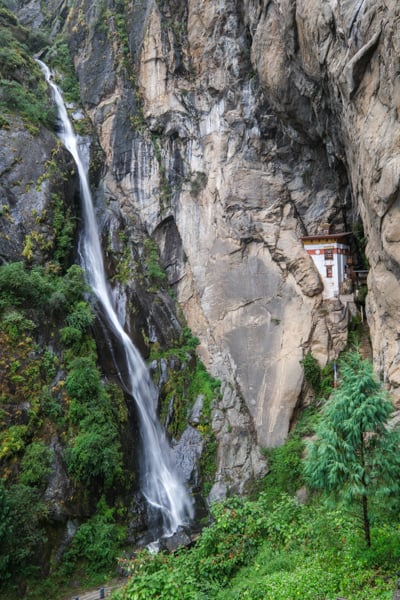
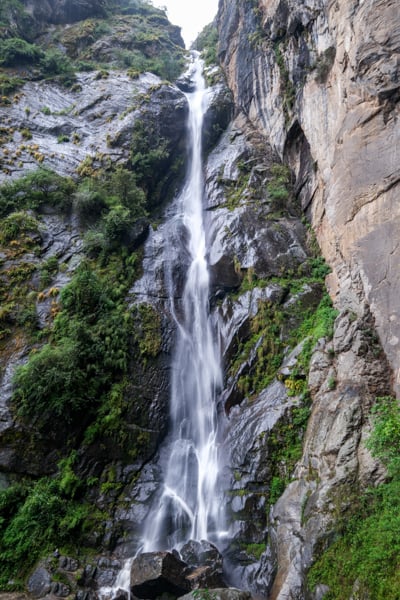
• Inside The Tiger’s Nest Monastery
Now that you’ve reached the Tiger’s Nest Monastery, it’s time to go inside. You can’t bring any bag, camera, or phone inside, but entering the Tiger’s Nest is still very worthwhile.
There are big, spacious lockers at the monastery entrance where you can store your camera stuff. My entire 30 liter backpack fit inside a locker just fine, with room to spare. I was a little nervous leaving my expensive gear here, but it was no problem.
The inside of the monastery has many interesting rooms and corridors, with a holy cave, temples, and small courtyards. Inside the temples, there are colorful paintings on the walls, and Buddhist monks chanting, praying, and burning incense.
• Viewpoints Above The Tiger’s Nest
If you still have extra time and energy after visiting the Tiger’s Nest, you can hike even higher on the opposite mountain.
Starting from the famous viewpoint, there’s a little used hiking path that leads up to several other interesting Bhutanese temples with sweeping views of the valley and Paro Taktsang.
Most tourists don’t know about this detour, so you can have the views all to yourself, and it gives you a unique perspective of the Taktsang monastery from above.
How Hard Is The Tiger’s Nest Hike?
The difficulty of the Tiger’s Nest hike will depend on your age and fitness level, and whether you’re acclimated to elevation before you start. If you’re a young and fit hiker, reaching the Tiger’s Nest will be fairly easy for you.
However, for most people, I would describe the hike as moderately difficult. It will definitely be challenging for older folks who don’t hike much, but it’s still doable if you take your time. I’ve heard of people as young as 3 and as old as 85 completing this hike, but not without some struggle.
There is quite a bit of uphill walking on rough terrain, and the relatively high top altitude of 3,100 meters (10,170 feet) adds another layer of challenge for us sea level dwellers. I got a headache after my first visit to Paro Taktsang, but some bedrest and ibuprofen cleared it up.
If you think you might have a hard time on this hike, I’d save it for later in your Bhutan itinerary, that way you’ll already be better acclimatized for the altitude. Besides, the Tiger’s Nest makes a nice ‘grand finale’ for your trip anyway, since it’s easily one of the most best things to do in Bhutan!
If you want to make things easier, you can also pay to rent a walking stick or horse at the start of the trail. However, the horses can only carry you to the Takstang cafe, which is approximately halfway to the monastery. You’ll still have to be able to walk the rest of the way yourself. If you’re disabled or in a wheelchair, the hike won’t be possible for you.
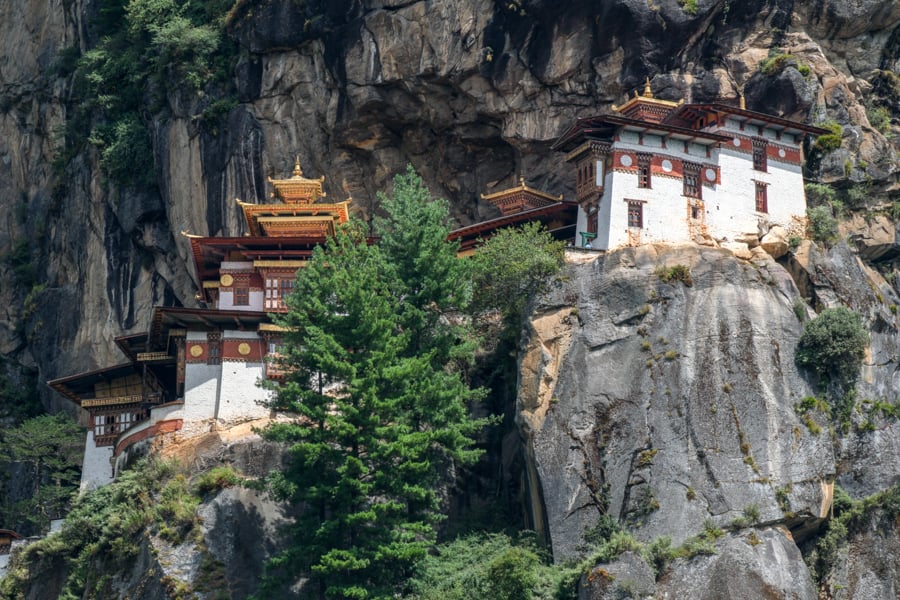
A zoomed in view of Paro Taktsang from below (300mm lens)
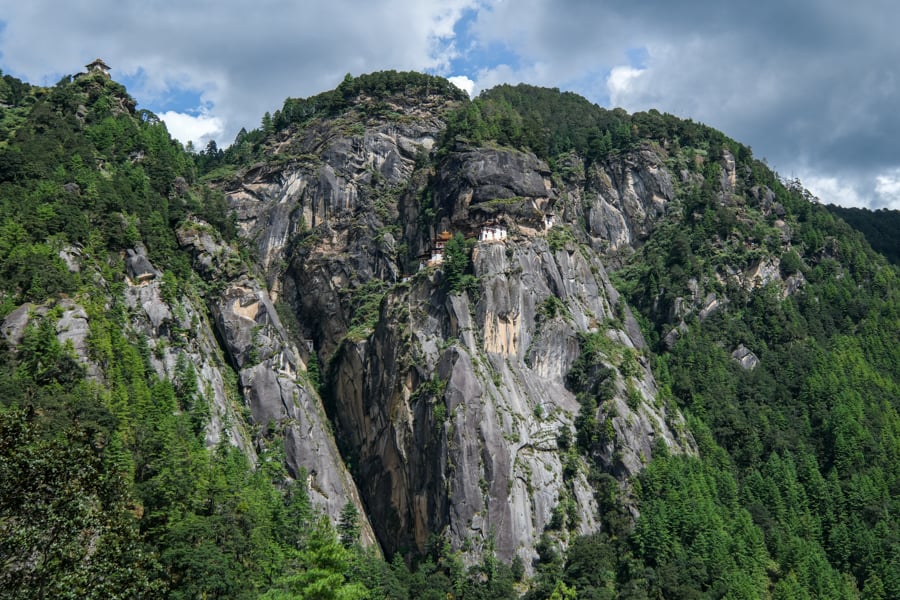
A wide angle (24mm) view from the Taktsang Cafeteria
How Long Is The Tiger’s Nest Hike?
The Tiger’s Nest hike can take anywhere from 4 to 8 hours roundtrip, depending on your fitness level. I would say 5 hours roundtrip is a normal time for the average person, not counting the time you spend taking photos and looking inside the monastery.
With no breaks, I reached the Taktsang cafeteria in about 45 minutes, and then reached the main viewpoint in another 45 minutes. Lastly, it took me another 15 minutes to hike from the viewpoint to the monastery and go inside.
This means I reached the monastery in less than 2 hours, but that’s an unusually fast pace. Most people will take longer, which is fine. It’s not a race. I was just anxious to see the Tiger’s Nest and take pictures!
In any case, even if you’re a fast hiker, you will need to devote a full day to visiting the Tiger’s Nest Monastery because you’ll want to spend plenty of time enjoying the views, taking photos, and touring the inside of the temple.
My Bhutanese tour guide told me that before the road was renovated in 2005, the trail was even longer and it took twice as much time to hike to the Tiger’s Nest Monastery. Nowadays, it’s quite a bit easier, but it’s still plenty of challenge.
My tour guide and I both agreed that the most special way to see the monastery is by hiking to it, and hopefully the Bhutanese government never builds a road leading all the way to the top of the mountain! That would ruin some of the experience.
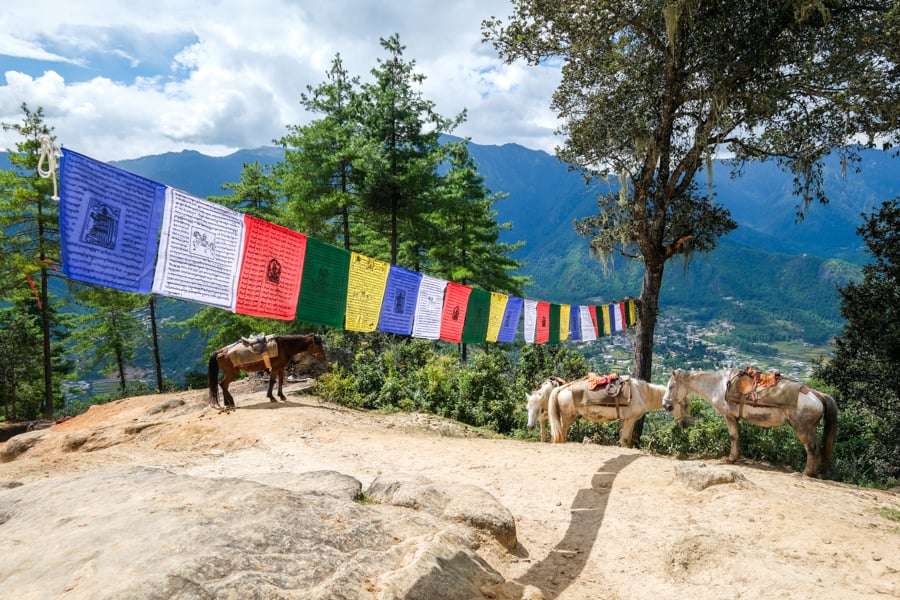
Ponies and prayer flags
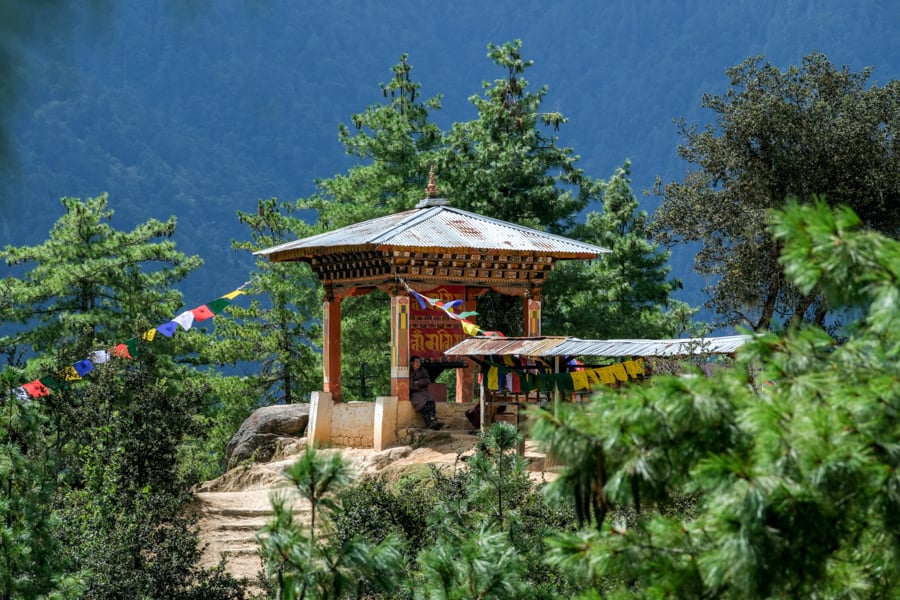
Mani wheel
Best Time To Visit The Tiger’s Nest Monastery In Bhutan
Generally the best time to visit Bhutan and hike to the Tiger’s Nest is in autumn (October to December) or spring (March to May), when the weather is dry and sunny. The shoulder months like September can also be good.
Don’t rule out cloudy or rainy days for visiting the Tiger’s Nest. While it may not be ideal, you can still take good pictures of the monastery even if it’s rainy. The first time I visited Taktsang it was very cloudy and rainy all day, but it gave everything a mysterious atmosphere with the clouds swirling around the mountain.
The best time of day to start the hike depends on your priorities. Most tours will start around 8 AM, and that should put you at the monastery before noon, which gives you lots of time to hike at your own pace, and then do plenty of sightseeing and photos there. The morning also has cooler temperatures for trekking.
However, you can potentially skip some of the crowds by starting later in the day, and the lighting is better for photos at that time anyway. On a sunny day, the best lighting for the Tiger’s Nest Monastery is actually around noon or later. Before that, you can still take nice pictures but the monastery will be partly or fully shaded.
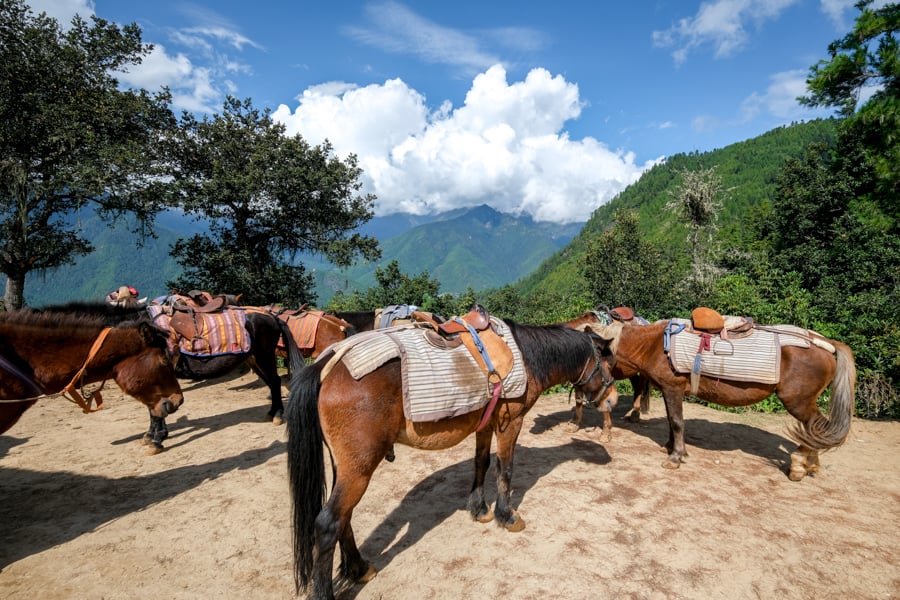
Horses can carry you halfway up the mountain, but you have to hike the rest.
What To Bring For The Tiger’s Nest Hike
- Hiking Shoes: The terrain on this hike can be steep and sometimes slippery, with occasional rocks, mud, or tree roots. You’ll want good hiking shoes or boots with grip.
- Jacket: Wear a light jacket that you can shed easily. You may be cold at first when you start the hike, but you’ll heat up quickly, especially if it’s a sunny day. Dress in layers.
- Sun Protection: It’s easy to get burned by the sun at this high altitude, so you’ll want to wear a hat and/or sunscreen.
- Water: It’s a good idea to bring at least 1 liter of drinking water. Your Bhutan tour guide can provide this for you. It’s also possible to buy extra bottled water from the cafeteria at the halfway point.
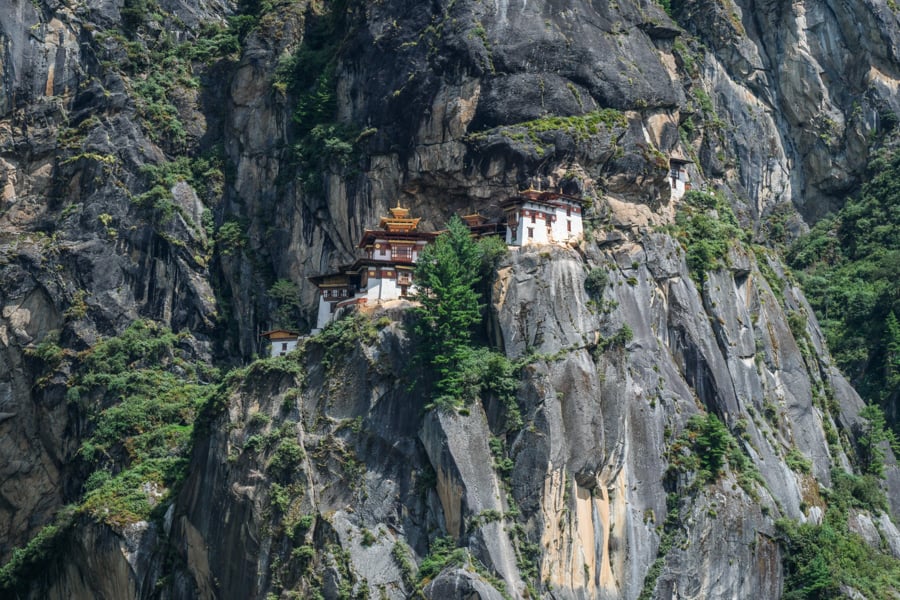
Temple perched on the cliff
Other Tips For The Tiger’s Nest Bhutan Hike
- Dress Code: The Paro Taktsang is an active Buddhist monastery, so you can only go inside with modest clothing (pants and long sleeves). Hats and shoes have to be taken off too. Outside the monastery, any clothing is okay as long as it’s not too revealing. There are bilingual signs at the viewpoint that say posing in inappropriate clothing is prohibited. That means no swimsuits or anything similarly revealing like that. Shorts and short sleeves are fine for the hike if you don’t plan to go inside the monastery.
- Bathrooms: There are toilets at the parking lot and also at the Taktsang cafeteria, which is the halfway point of the hike. There are also toilets at the monastery itself, although I’ve heard they’re very dirty. The toilets at the cafe are free to use, but there was a small cash fee to use the ones in the parking lot. Aside from this, there are also some places off the trail where you can go in the bushes if you really need to.
- Cell Service: If you have a Bhutanese SIM card, there’s some reception all along the whole hike, so you can make calls or send texts if needed. There was no WiFi at the Taktsang cafeteria when I went, although I wouldn’t be surprised if they add that soon.
- Horses: You can ride a horse halfway to the monastery for a fee. The horses are healthy and well cared for. My tour guide said the more expensive horses (for ~$20 USD) are better trained and safer than the cheap ones ($10). He said some tourists have fallen and broken arms or worse. He was not trying to sell me on this service, so I’m inclined to believe him. If I rode a horse here, I would try to get the best and most experienced horse out of the lineup.
- Mosquitoes: I only saw one or two mosquitoes on the hike, and if you’re wearing pants they shouldn’t be an issue at all. There is no presence of Malaria in the Paro district of Bhutan, so you don’t have to worry about that either.
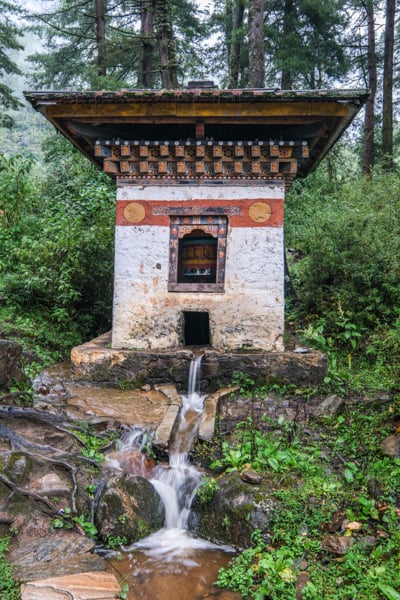

Monastery Hours & Entrance Fees
- Hours: 8 AM – 1 PM and 2 PM – 5 PM
- Entrance Fee (Adults): 2,000 BTN ($25 USD)
- Entrance Fee (Kids 6-18): 1,000 BTN ($12 USD)
- Entrance Fee (Kids 0-5): Free
These are the current opening hours and entrance fees as of 2024, but you might want to double check with your Bhutan tour guide before you go, as it may change occasionally. This is only for entering the monastery. You can start the hike at any time of day, and there’s no fee for the hike.
Also, keep in mind most Bhutan tour packages already include these entrance fees in the total tour price, so you generally won’t have to pay anything when you enter the monastery. The entrance fees only apply to tourists visiting the monastery independently.

Monkey hiding in the bushes
Frequently Asked Questions (Paro Taktsang)
- What does Taktsang mean in English?
The name Taktsang means ‘tiger’s lair’ in Tibetan. According to legend, the Indian guru Rinpoche (also known as Padmasambahva) was transported to the cave on the back of a tigress, giving this place the name it has today.
- Are there wild tigers here?
No, there aren’t wild tigers living in the Paro area anymore, but they still live in other parts of Bhutan. If you’re lucky, you can see Bengal tigers in the Jigme Singye Wangchuck or Royal Manas National Park. Both of these parks are in central Bhutan.
- Where is Taktsang located?
Taktsang is located on a steep cliff outside of Paro town, in western Bhutan. You can drive to the starting point in 30 minutes from Paro town, but the only way to reach the monastery is by hiking to it.
- When was Paro Taktsang built?
The Tiger’s Nest Monastery was formally built in 1692, although its history as a Buddhist meditation cave dates back to the 9th century. Today, it’s a famous icon of Bhutan, and the cliffside monastery was even featured on the back of the country’s 5 ngultrum cash notes.
- Can kids do the Tiger’s Nest hike?
Yes, kids can hike to the Tiger’s Nest, but I would definitely try to get acclimated to the altitude before doing the hike with kids. I would say 7 is a good age, although I’ve heard of younger kids doing it as well. I wouldn’t recommend kids going on horseback here, because the seat is high for kids and the ponies can be a bit erratic since the path is rough. It would be easy for a kid to fall from a horse here, and they could be seriously injured if that happened.
You can hike slowly, take your time, and drink lots of water. If your kids are having too much difficulty on the hike, you can always turn around at the cafeteria or later, while still getting some views of the Tiger’s Nest.
- How many steps up to the Tiger’s Nest in Bhutan?
There isn’t an exact count of how many steps the hike takes since it’s mostly a dirt trail, but the final section alone has hundreds of stone steps. Some sources say there are 700 stone steps to go from the viewpoint to the monastery. All in all, it’s quite a workout, but it’s worth every minute!
- What is the UNESCO status?
The Tiger’s Nest Monastery hasn’t been recognized as a UNESCO World Heritage Site yet, but that could change. It was submitted as a tentative site in 2012. Hopefully soon it’ll get the recognition and protection it deserves!
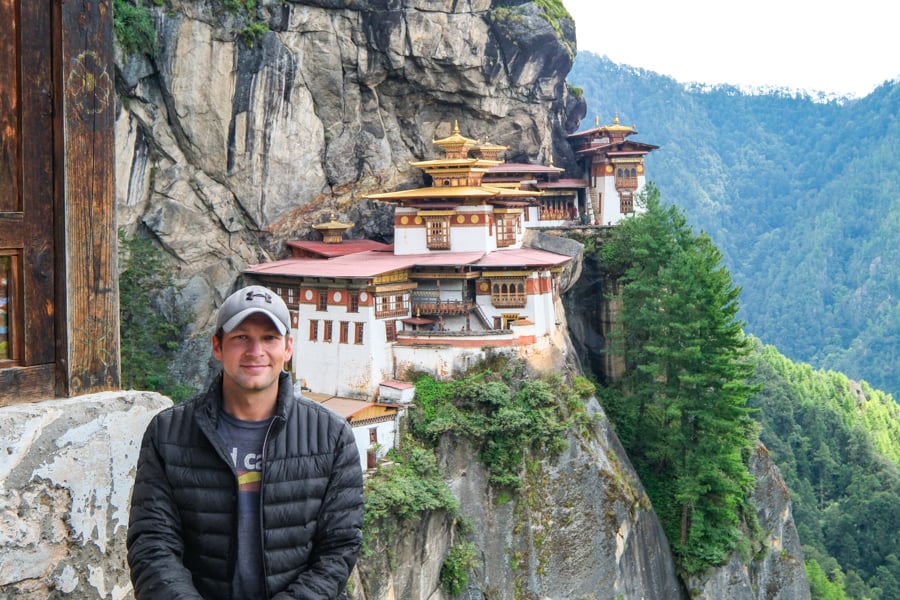
The Tiger’s Nest is probably one of my favorite views in the world
Best Bhutan Tour Company
For most nationalities, the only way you can visit Bhutan is with a visa and tour organized by a local Bhutanese tour company. There’s also a daily tax of $100 USD per person, which is a rule established by the Bhutanese government to try to ensure ‘quality over quantity’ tourism.
I visited Bhutan with this tour company on GetYourGuide. It was a great experience, and I would happily recommend them to anyone! The owner of the company, Tsenrig, helped me craft the perfect 7-day Bhutan itinerary, with a visit to the Tiger’s Nest Monastery and lots of other great sights around the country of Bhutan.
Their most popular itineraries are 5 or 7 days, but they also have tours of 9 or 10 days, or even as long as 15 or 20 days. The itinerary is very flexible and you can choose the sights you most want to see on each day you spend in the country of Bhutan.
My private tour guide, L. Dorji, was fantastic and very helpful, staying at my side every step of the way. He even kindly insisted to carry my heavy backpack for me, and helped me swap between my camera lenses whenever I was taking pictures.
Dorji knew every detail about the history of Bhutan, and he’s been doing the trek to the Tiger’s Nest for decades. He was one of the best tour guides I’ve had anywhere in the world. Overall, I would highly recommend this company for your hike to the Tiger’s Nest Monastery in Bhutan!
Book Now: Bhutan Tour 5 / 7 / 9 Days
More Bhutan Travel Tips
Thanks for looking! I hope you enjoyed this travel guide for the Tiger’s Nest Monastery hike in Bhutan. It was one of my favorite experiences in this little Asian country.
I’ll be adding more Bhutan tips to my travel blog soon, so don’t forget to bookmark it and check back later!
See Also
- Bhutan Travel Itinerary: Best Things To Do & See
- 5 Day Bhutan Tour By GetYourGuide
- 7 Day Bhutan Tour By GetYourGuide